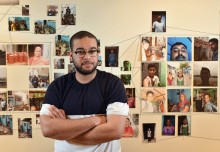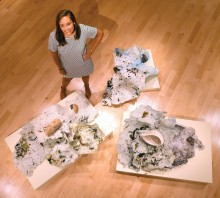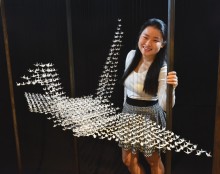Talent show
PICTURED ABOVE: The senior studio art majors exhibition featured the creations of 22 students: Sydney Beck, Xiangzi Chen, Gaoziyan Cui, Nickolas Falla, Margaret Frothingham, Emery Kennett, Sarah Knittle,Merrill McCluskey, Kathryn Muehlberger Madeline Parker, Karl Rivera, Margaret Robe, Galen Robinson, Mary Sawyer, Chenyang Shi, A. Walker Stockly, Jenna Tewksbury, Mei Lan Thompson, Chloë Urbanczyk, Sienna Van Slooten, Elise Waelder, Hongting Wang.
This spring, 22 students in the Studio Art Senior Seminar exhibited more than 120 artworks in a variety of mediums in the Beard and Weil Galleries. The exhibition title, “Muse of Form,” was chosen by the group as “a reflection on how they rely on the primacy of visual language, of form, to spark their imaginations, and to communicate their ideas and feelings,” said Professor of Art Claudia Fieo, senior seminar advisor. Here, we asked a few of the artists about their work and their experience at Wheaton.
Karl Rivera
“I created an interdisciplinary major in visual sociology with professors Andrew Howard and John Grady because I have a keen interest in the way visual documents illuminate parts of our social world that text alone cannot. I use photography steeped in sociological methods and theory to critically analyze and understand the social organization and relationships within our societies. I have really loved the meaningful relationships that I’ve developed with professors.
They have shown me that my ideas (as radical and non-conforming as they may be) hold weight and are valuable. Ultimately, they have helped me to develop a deeper confidence in my artistic and academic scholarship. Wheaton has taught me to think critically and to challenge incredibly well-rooted rhetoric with grace. I’ve learned how to ask better questions and deal with answers that aren’t always easy.”
 Merrill McCluskey
Merrill McCluskey
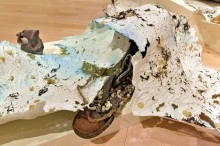
 Mei Lan Thompson
Mei Lan Thompson
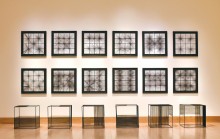
Sydney Beck
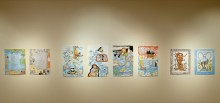
In the years of armed conflict and civil unrest since the beginning of the war, Syrian civilians have suffered both at the hands of their own authoritarian government, the terrorist organization ISIS, and the self-serving and ignorant intervention of foreign powers. 4.5 million people, mostly women and children, have fled Syria and over 6.5 million have been internally displaced. Those who have stayed have had to face the destruction of their livelihood, safety, community, and cultural heritage. Those who have left have endured inhumane living conditions in camps, fear of drowning in the Mediterranean, and indifference and rejection from those who would take them in.
The public and political discourse in the U.S. concerning the situation has been skewed, fragmented and stereotypical, often ignoring the human dynamics, the human experience of the refugees themselves. Images from the media, both heart-wrenching and frightening, were my window into their world. The more I saw, the more I became frustrated that these photographs could only do so much to affect peoples’ understanding. Despite the proliferation of images depicting Syrians at their most vulnerable, political candidates continued to disparage and vilify the refugees, using fear to influence.
In my desire to find understanding I came to realize that compassion is self-referential; we relate to others based on our own experience. Through the incorporation of images—the ocean, flowers and plants, scenes of childhood, my mother’s favorite teacup—which symbolize meaningful details of my home and the identity I have built around it, I sympathize with the Syrian peoples’ profound loss of home. In these illustrations I seek to capture how fragile humanity is when we lose our sense of place. Though I cannot begin to imagine the experience of these Syrian families and will never be able to speak for them, I will continue to advocate and pray that some day they will once again feel the warmth and fellowship of home, no matter on which continent they plant their feet or which river their lips touch.
Mary Sawyer
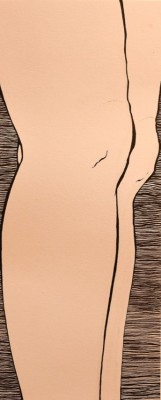
I may be.
Over the past year I have lost some weight, and I am always noticing something new about the transformation my body has recently undergone. At the same time, I
have been working on my resume, which is like a mask that gives a person control over how they want their image to be perceived. It feels like lying, and has increasingly bothered me.
As a response to these two current preoccupations, I created snippets of self-portraiture. I wanted to examine myself on multiple levels and in multiple moments.
I wanted to depict and objectify many levels of distance—how a stranger or friend might see me, or how I see myself in the mirror or looking down at my body. I wanted the viewer to notice both the parts of me I was proud of, and the flaws that still deeply bothered me. I wanted to know how I am perceived by others; and ultimately, I wanted
to learn how I want to perceive myself.
Sarah Knittle
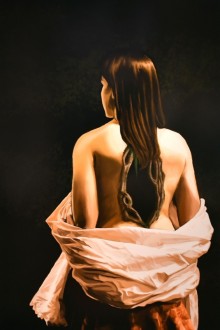
Every time they are told, there are often little variations, some insignificant—Cinderella’s slippers are sometimes gold instead of glass; maybe there is no fairy godmother; or the gown is bestowed upon her by the birds at her mother’s grave—either way the story still happens all the same. Sometimes the changes are more significant in how we perceive them. Cinderella’s stepsisters mutilate themselves to fit into the shoe and are then pecked to death by the same birds that helped Cinderella get to the ball; and sometimes none of that happens and Cinderella forgives them as she leaves to marry the prince. What does it say about the heroine of this story if she lets her stepsisters suffer over forgiving them? Do we value vengeance or mercy?
Women in fairy tales and folklore inspired these paintings. They are stories I have grown up with and always loved. I am also fascinated by the different kinds of women portrayed, their role in their stories, how we view them, and how a small change can alter their entire character. A proud martyr is viewed differently than a damsel in distress. A survivor is different from a victim. A woman empowered and in charge of her own body is different from a lethal seductress.
Painting with a digital brush, tablet and pen using Adobe Photoshop, these portraits are digital illustrations, a modern method to an historic tradition.
Elise Waelder
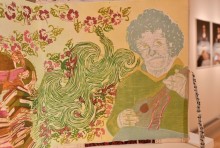
In the fall of this year, I began developing imagery for my independent study based on my home in California. Without realizing it, memories of my dad started to surface. I decided to combine my passion for relief printmaking and graphic design to create an accordion-fold book that would help me better understand and honor his life. The evolutions of these pages include cherished memories that I shared with my dad, including significant objects, imagery taken from old family photographs, and designs based on his Hawaiian shirts. Because Relief Printmaking is an incredibly tedious and demanding process, I was forced to reach inside myself and work through my emotions even when I didn’t want to face them.
Before the conception of this project, I had never given myself the time or space to absorb and accept his death. The process of making this book has finally allowed me to do just that. During the last eight months I have discovered how powerfully healing art can be. It has granted me the opportunity to reconnect with my father in a way I didn’t think was possible.
Sienna Van Slooten
If we take the time to discover detail, especially in nature, our experience is greatly enriched.
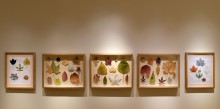
Captivated by our own complexities, we as humans tend to lose sight of the intricacy of other living organisms. Fractals exponentially expand inward in all of nature, and yet our entire elaborate world is but a speck in the universe. I want to point out the simultaneous significance and insignificance of everything in life, this fascinating relationship that exists naturally, through the leaves in my piece.
We may observe the death of leaves during the fall, but we don’t pause to study and admire the details of that death—the traces of it in the leaves’ appearance. Their veins and designs convey a profound world within, while their markings and color reflect the place and season when they fell from their trees.
I plan to continue this project even afterWheaton, and make hundreds of leaves, better emphasizing the macro view through their number and the micro view through their detail.
Madeline Parker
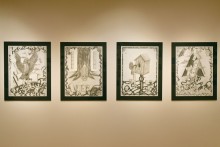
“It’s ludicrous,” Olivia started, “For any of you to think that I would want to take part in this. I want nothing, and I mean nothing, to do with this.”
As Christopher opened his mouth to retaliate, Olivia spoke over him, “It is what my father wanted, I get it. For the hundredth time, Chrissy, I get it.”
“Chrissy?” Felix wheezed with laughter.
Christopher raised his voice in an attempt to filter out Felix scoffing at his unfortunate nickname. “Listen, Olivia, by now, SPANA has long been searching you out. While it would be temporary, this is the only way we will be able to evade their view. If you keep walking away from this, we won’t be able to protect you.”
“I don’t need, or want, your protection,” Olivia retorted as she pressed her fingers against the bridge of her nose.
Mysteries have always been an engaging part of our culture. The uncertainty and meticulous detail behind these works of art have found their way into our hearts when we ask ourselves “what happens next?” We, as human beings, seek this complexity through various forms of art, whether it is illustration or writing. Because I have felt a strong connection towards peripeteia, a sudden change in circumstance, I wanted to explore the sense of secrecy through a twisting and turning ofunanticipated events in writing my own story. To parallel my story and my love for mystery, I created meticulously drawn anthropomorphic representations of each character. Renderingiconography found in my story, and a card suit closely tied to each of the characters, I utilized thin, tight pencil marks to capture how detail-oriented their misadventures are, and how they are consumed in their own worlds.
“You can’t expect me to apologize. Sacrifices need to be made.”
Emery Kennett

Wanting to create my own story, I turned to museums for my inspiration. Since I am often inspired by the quirkiness in people, I find that I am always drawing myself, friends, family, and even strangers. Somehow the most unique characteristics of the people I know inevitably would creep into the illustrations of my own fictional characters. Floating on a white page these imaginary two-dimensional people needed a colorful world of their own. Designing a museum, as eccentric as my characters seemed to be the perfect setting for my story to unfold.
Margaret Frothingham
“In a little town, on dusty road, in a yellow car, Elise stares out the back of her window…”
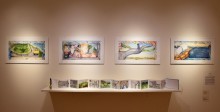
As often as I might wish to escape, I also revel in the moments when beauty surrounds me. Since childhood, Nantucket Island has been a source of inspiration and emotion for me. After traveling to Italy and Ireland, I came back to Nantucket this past summer an entirely different person. In my drawings, I tie places together through common links, communicating how I see the world—through cracks, windows, flowers, and small moments—which have the ability to transport our minds through association and memory. Recently, my family has decided to break its ties with the island, a decision that has been very hard for me to accept.
Just as the young girl in Elise’s Escape, a children’s story I wrote and illustrated, dreams to be in a place other than where she is, this same desire applies to my own personal journey. My accordion-fold artist book project, Postcards to the Horizon, acts as both a goodbye and a hello. Beginning and ending in the same location, it opens a windowinto the changes I’ve faced in the past year. Every day, my heart aches to see Ireland again and, sometimes, if I look at the world a certain way, I can find bits of its magic in the everyday.
Ultimately, through my graphite and watercolor illustrations, I am asking viewers to reflect on their own childhood and open their eyes to the mysteries and wonders beyond the ordinary.
Nickolas Falla
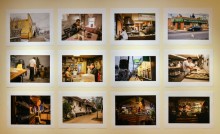
My upbringing has led me to see the world from two different perspectives; one with Guatemalan heritage, language, and culture; the other from my own experiences traveling and studying in the United States.
During my first year at Wheaton, two fellow Guatemalan students invited me to dinner at a small Guatemalan restaurant in Attleboro. When I first stepped into the restaurant, I could not believe my eyes. I could not believe my nose. I could not believe I was in Attleboro, Massachusetts. It was so exciting for me to eat traditional food that I needed to go back.
For the past two years, I have been getting to know Guatemalan hotspots in Providence and Attleboro. I am teleported to Guatemala every time I visit these communities. My Latino side emerges: I change speeds, I change language, and I no longer feel as if I am in the United States. Though I notice people make initial judgments about me, the instant I start speaking Spanish though, the room stops moving, and people are stunned, half in disbelief, half wanting to ask me questions, excited to hear that I am a chapin too.I like exchanging stories with fellow chapines about Guatemala. It helps me remember my true home.

